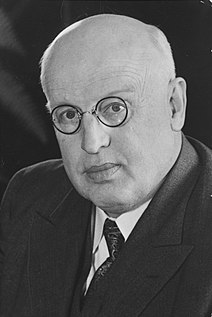The Canadian social credit movement is a Canadian political movement originally based on the Social Credit theory of Major C. H. Douglas. Its supporters were colloquially known as Socreds in English and créditistes in French. It gained popularity and its own political party in the 1930s, as a result of the Great Depression.
The Alberta Social Credit Party was a provincial political party in Alberta, Canada, that was founded on social credit monetary policy put forward by Clifford Hugh Douglas and on conservative Christian social values. The Canadian social credit movement was largely an out-growth of the Alberta Social Credit Party. The Social Credit Party of Canada was strongest in Alberta, before developing a base in Quebec when Réal Caouette agreed to merge his Ralliement créditiste movement into the federal party. The British Columbia Social Credit Party formed the government for many years in neighbouring British Columbia, although this was effectively a coalition of centre-right forces in the province that had no interest in social credit monetary policies.
The Reconstruction Party was a Canadian political party founded by Henry Herbert Stevens, a long-time Conservative Member of Parliament (MP). Stevens served as Minister of Trade in the Arthur Meighen government of 1921, and as Minister of Trade and Commerce from 1930 to 1934 in the Depression-era government of R. B. Bennett.

The Social Credit Party of Canada, colloquially known as the Socreds, was a populist political party in Canada that promoted social credit theories of monetary reform. It was the federal wing of the Canadian social credit movement.
Unity, United Progressive Movement and United Reform were the names used in Canada by a popular front party initiated by the Communist Party of Canada in the late 1930s.
Liberal-Progressive was a label used by a number of candidates in Canadian elections between 1925 and 1953. In federal and Ontario politics, there was no Liberal-Progressive party: it was an alliance between two parties. In Manitoba, a party existed with this name.

The United Farmers of Alberta (UFA) is an association of Alberta farmers that has served different roles in its 100-year history – as a lobby group, a successful political party, and as a farm-supply retail chain. As a political party, it formed the government of Alberta from 1921 to 1935.
Historically in Quebec, Canada, there were a number of political parties that were part of the Canadian social credit movement. There were various parties at different times with different names at the provincial level, all broadly following the social credit philosophy; at various times they had varying degrees of affiliation with the Social Credit Party of Canada at the federal level.
John C. Turmel is a perennial candidate for election in Canada, and according to the Guinness World Records holds the records for the most elections contested and for the most elections lost, having contested 101 elections and lost 100. The other contest was a by-election that was pre-empted by a general election call.

The 1945 Canadian federal election was the 20th general election in Canadian history. It was held June 11, 1945 to elect members of the House of Commons of Canada of the 20th Parliament of Canada. Prime Minister William Lyon Mackenzie King's Liberal government was re-elected to its third consecutive government, although this time with a minority government as the Liberals fell five seats short of a majority.

The 1940 Canadian federal election was the 19th general election in Canadian history. It was held March 26, 1940, to elect members of the House of Commons of Canada of the 19th Parliament of Canada. Prime Minister William Lyon Mackenzie King's Liberal Party was re-elected to their second consecutive majority government.
The Manitoba Social Credit Party was a political party in the Canadian province of Manitoba. In its early years, it espoused the monetary reform theories of social credit.
The Social Credit Party of Saskatchewan was a political party in the Canadian province of Saskatchewan that promoted social credit economic theories from the mid-1930s to the mid-1970s.

The 1940 Alberta general election was the ninth general election for the Province of Alberta, Canada, was held on March 21, 1940, to elect members of the Legislative Assembly of Alberta.

Stony Plain, originally named Stonyplain, was a provincial electoral district in Alberta, Canada, mandated to return a single member to the Legislative Assembly of Alberta from 1905 to 2019. The district returned a single member to the Legislative Assembly of Alberta throughout its history, using the first past the post method of voting for most of its existence but single transferable vote from 1926 to 1957.

Lethbridge is a federal electoral district in Alberta, Canada, that has been represented in the House of Commons of Canada since 1917. It incorporates the City of Lethbridge and Lethbridge County.
The Alberta Unity Movement, also known as the Independent Movement and later the Independent Citizen's Association, the People's League, was a political movement and lobby group in Alberta, Canada formed in 1937 in an attempt to unite the opposition against the Social Credit government of William Aberhart. It was created as a lobby group to promote independent candidates before the 1940 general election. The Conservative and Liberal parties, and the more conservative remnants of the United Farmers, recognizing the widespread popularity of the Social Credit party, ran joint candidates as independents in what was called the "Independent Movement" or the "Unity Movement". Calgary mayor Andrew Davison was named leader.
The Manitoba Social Credit Party ran 43 candidates in the 1953 Manitoba election, two of whom were elected. Some of these candidates are individual biography pages. Information about others may be found here.
National-Unity is the banner under which Robert Rae Manville stood as a candidate in Prince Albert in the 1940 federal election in Canada. The Liberal candidate in the riding was Prime Minister William Lyon Mackenzie King and Manville, a merchant, placed second with 7,534 votes and 41% of the vote, less than 1,000 votes behind the Prime Minister.





